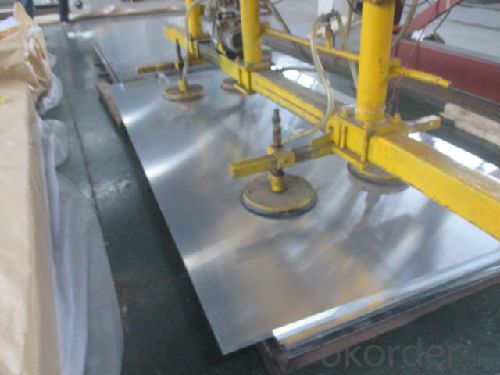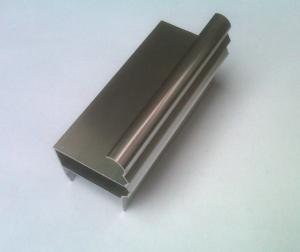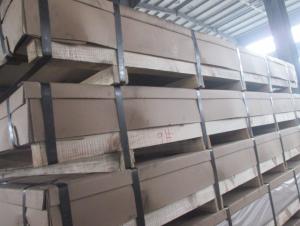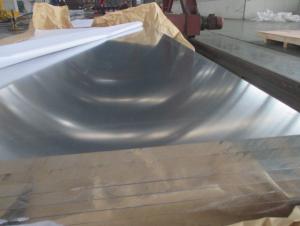Aluminum Sheet Plate Stocks Warehouse Cold Rolled Price
- Loading Port:
- Shanghai
- Payment Terms:
- TT or LC
- Min Order Qty:
- 8 m.t.
- Supply Capability:
- 5000 m.t./month
OKorder Service Pledge
OKorder Financial Service
You Might Also Like
1.Structure of Product Description
Cold rolled aluminum sheet is widely used in the field of construction field and decoration field, etc.
There are many different grades, such as: 1000 series, 2000 series, 3000 series, 5052,5754,5083,6061,6063,8011, etc.
The temper is include H14, H22, H24, H44,H112,H114,etc.
2. Main features of the product
a.Competitive price
b.Frist-Class Service.
c. Shortest service.
3. Image.


4. Product detailed sizes:
1000mm*2000mm, 1219mm*2438mm,1220mm*2440mm, 1250mm*2500mm,1500mm*3000mm, etc.
5. FAQ:
What is the quality standard?
---Usually our standard is GB3880-2006 or others.
What is the width range?
---It is from 1000mm to 2500mm, etc.
---Normally it is around 9000 tons totally.
Where is your client from?
---Normally it is from Japan, USA, ENGLISH, SINGAPORE, ETC.
What is your mainly products?
---Normally they are aluminum sheet, checkered sheet, mirror finish aluminium sheet, aluminum casting coil, etc.
- Q:What is the price of fluorocarbon coated aluminum profiles, please?
- Powder sprayed surface of about 2W a meal, fluorocarbon two or three coated difference about 800 yuan, 2.5W a meal bar, depends on what brand products, this price is now according to the aluminum ingot price estimate
- Q:What are the surface finishes available for aluminum profiles?
- Some common surface finishes available for aluminum profiles include anodizing, powder coating, polishing, brushing, and chemical etching.
- Q:How does the aluminum profile bevel come round?
- You can try it yourself and make a small tool to fix this angle in advance.
- Q:Are aluminum profiles energy-efficient?
- Yes, aluminum profiles are energy-efficient. Aluminum is a highly conductive material, allowing for efficient heat transfer and reducing energy losses. It is also lightweight, making it easier to transport and install, saving energy in the process. Additionally, aluminum profiles can be designed with thermal breaks or insulation to further enhance their energy efficiency.
- Q:Are aluminum profiles suitable for lighting fixtures?
- Yes, aluminum profiles are highly suitable for lighting fixtures. Aluminum is a versatile and lightweight material that offers several advantages for lighting applications. Firstly, aluminum profiles have excellent thermal conductivity, which means they effectively dissipate heat generated by the lighting fixtures. This is crucial as excessive heat can reduce the lifespan of the lighting components and affect their performance. Aluminum profiles help to maintain a cooler operating temperature, thereby enhancing the longevity and efficiency of the lighting fixtures. Secondly, aluminum profiles are corrosion-resistant, making them suitable for indoor and outdoor lighting fixtures. This resistance to corrosion ensures that the fixtures can withstand harsh environmental conditions, such as high humidity or exposure to moisture, without deteriorating or losing their functionality. Furthermore, aluminum profiles are easily customizable and can be designed to accommodate various lighting requirements. They can be extruded into different shapes and sizes, allowing for flexibility in the design of lighting fixtures. This versatility enables manufacturers to create sleek and modern lighting solutions that can be seamlessly integrated into different spaces and architectural designs. In addition, aluminum profiles offer aesthetic appeal as they can be powder-coated or anodized in various colors, providing a wide range of options to match different interior or exterior design themes. Lastly, aluminum is a sustainable material that is fully recyclable. Opting for aluminum profiles in lighting fixtures contributes to reducing environmental impact and supports the principles of sustainability. Overall, due to their thermal conductivity, corrosion resistance, versatility, aesthetic appeal, and sustainability, aluminum profiles are highly suitable for lighting fixtures and are widely used in the lighting industry.
- Q:Are there any regulations or standards that aluminum profiles must meet?
- Yes, there are several regulations and standards that aluminum profiles must meet in order to ensure their quality and safety. These regulations and standards vary depending on the specific application and industry, but some common ones include: 1. ISO Standards: The International Organization for Standardization (ISO) has developed various standards for aluminum profiles, such as ISO 9001 for quality management systems, ISO 14001 for environmental management systems, and ISO 9001 for occupational health and safety management systems. 2. ASTM International Standards: ASTM International provides standards for aluminum profiles used in construction, transportation, and other industries. These standards outline the chemical composition, mechanical properties, and dimensional tolerances that aluminum profiles must meet. 3. American National Standards Institute (ANSI) Standards: ANSI develops standards for aluminum profiles used in various applications. These standards cover aspects such as design, performance, and safety requirements. 4. European Standards (EN): In Europe, aluminum profiles must meet the requirements of the European Committee for Standardization (CEN). These standards define the characteristics, dimensions, and tolerances of aluminum profiles used in construction, aerospace, automotive, and other industries. 5. National Regulations: Many countries have their own regulations governing the use of aluminum profiles. These regulations may cover aspects such as fire safety, structural integrity, and environmental impact. It is important for manufacturers, suppliers, and users of aluminum profiles to adhere to these regulations and standards to ensure the quality, reliability, and safety of their products and applications. Compliance with these standards helps to maintain consistency, interoperability, and customer confidence in the use of aluminum profiles across various industries.
- Q:Does aluminum alloy profile conduct electricity?
- Aluminum conducts well, and aluminium alloys must also be electrically conductive. But aluminum alloys contain impurities such as silicon and magnesium
- Q:Can aluminum profiles be used in the production of audiovisual equipment?
- Yes, aluminum profiles can be used in the production of audiovisual equipment. Aluminum is a lightweight and durable material that can be easily molded into various shapes and designs. It offers excellent heat dissipation properties and is resistant to corrosion, making it suitable for audiovisual equipment such as speaker stands, camera mounts, and TV brackets. Additionally, aluminum profiles can be customized to fit specific requirements, providing flexibility in design and construction.
- Q:Are aluminum profiles suitable for use in the marine industry?
- Yes, aluminum profiles are suitable for use in the marine industry. Aluminum is a lightweight, durable, and corrosion-resistant material, making it ideal for various marine applications, including boat building, shipbuilding, and offshore structures. Its high strength-to-weight ratio allows for efficient and reliable construction, while its resistance to saltwater and harsh environmental conditions ensures longevity. Additionally, aluminum profiles can be easily fabricated, providing flexibility in design and customization. Overall, aluminum profiles offer numerous advantages that make them well-suited for use in the marine industry.
- Q:What are the fire-resistant properties of aluminum profiles?
- Aluminum profiles possess several fire-resistant properties that make them a suitable choice for various applications. First and foremost, aluminum has a high melting point of approximately 660 degrees Celsius (1220 degrees Fahrenheit), which means it can withstand high temperatures without melting or losing its structural integrity. Moreover, aluminum has a low ignition point, meaning it requires a higher temperature to ignite compared to other metals. This property makes it less susceptible to catching fire when exposed to heat or flames. In the event of a fire, aluminum profiles form a protective layer of aluminum oxide on their surface due to their natural oxide layer. This layer acts as a barrier, preventing the further spread of flames and inhibiting the combustion process. Additionally, the aluminum oxide layer is highly heat resistant, providing additional protection against high temperatures. Furthermore, aluminum profiles are non-combustible, meaning they do not contribute to the spread of fire. This characteristic is crucial in fire safety as it helps to contain the fire within a specific area and prevent its rapid expansion. Overall, the fire-resistant properties of aluminum profiles, including high melting point, low ignition point, the formation of a protective oxide layer, and non-combustibility, make them a reliable choice for various applications where fire safety is a concern.
1. Manufacturer Overview |
|
|---|---|
| Location | |
| Year Established | |
| Annual Output Value | |
| Main Markets | |
| Company Certifications | |
2. Manufacturer Certificates |
|
|---|---|
| a) Certification Name | |
| Range | |
| Reference | |
| Validity Period | |
3. Manufacturer Capability |
|
|---|---|
| a)Trade Capacity | |
| Nearest Port | |
| Export Percentage | |
| No.of Employees in Trade Department | |
| Language Spoken: | |
| b)Factory Information | |
| Factory Size: | |
| No. of Production Lines | |
| Contract Manufacturing | |
| Product Price Range | |
Send your message to us
Aluminum Sheet Plate Stocks Warehouse Cold Rolled Price
- Loading Port:
- Shanghai
- Payment Terms:
- TT or LC
- Min Order Qty:
- 8 m.t.
- Supply Capability:
- 5000 m.t./month
OKorder Service Pledge
OKorder Financial Service
Similar products
New products
Hot products
Hot Searches
Related keywords






























